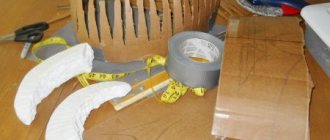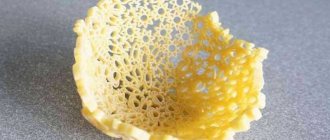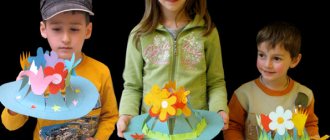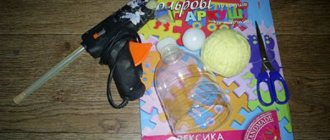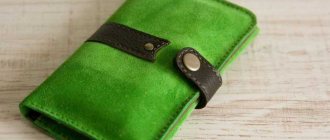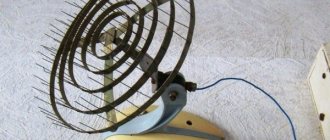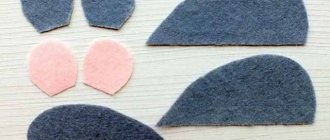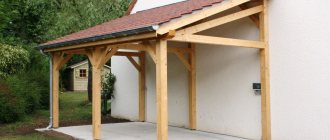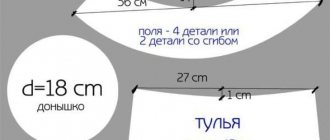What little boy doesn’t imagine himself as an epic hero? Who, in their dreams, does not see themselves with a sword in their hands, destroying enemies on a beautiful horse? Naturally, most boys will be happy to appear at a school event in the guise of one of the heroes - Ilya Muromets, Dobrynya Nikitich or Alyosha Popovich.
There is no need to talk about a mighty horse, but it is quite possible to make such heroic accessories as a helmet, shield and sword at home.
Interesting Facts
Archaeological excavations have shown that primitive people began to protect the head. They used tree branches and animal skins for this. The very first images of helmets made of metals (gold and silver) date back to the 3rd millennium BC.
It is impossible to imagine a heavily armed warrior (hoplite) of the Hellenic era without a Corinthian or Boeotian type of helmet.
Helmets were used by the peoples of Asia Minor, and by the warriors of the East, and by European knights, and by knights in Rus'. In principle, this effective head protection has survived to this day, transformed into the helmets of modern soldiers.
Hero costume
As such, the special production of an epic hero’s outfit will not cause difficulties. Any wardrobe will contain:
- pants and shirt;
- toy sword and shield;
- belt and boots.
Instead of a cloak, you can throw on a piece of bright fabric, secure it with a sash and a brooch, that’s the whole outfit of a medieval warrior.
If the boy does not have a sword and shield, it is very easy to cut them out of cardboard, color them and give them to the defender of the Fatherland from enemies and mythical villains.
If there are no problems with the suit and conventional “weapons,” then making a helmet will require some effort. But even here, there is no need for any supernatural actions, special skills or the acquisition of special materials and tools.
Carnival knight costume, master class | Sewing Advisor
The knight's carnival costume will not leave any boy indifferent! A helmet with a visor, a shield and a tunic with a coat of arms - and a brave knight is in front of you. Find a matching sword at the toy store to complete the look.
We will tell you how to sew a knight costume from fabric and felt with your own hands in just a few hours!
How to sew a knight costume with your own hands?
We used felt for the helmet, shield and emblem on the tunic, and the tunic is made of thin knitwear. You can use any material for your tunic (except something that is too thin or transparent). We recommend knitwear, fleece or felt: these materials have a non-fraying cut and do not require edge processing.
To calculate the amount of fabric, measure the width of your child's shoulders and the desired length of the tunic. You will need a piece of fabric equal to the width of the shoulders plus 3-5 cm if the double length of the tunic does not exceed the width of the fabric. If you have leftover fabric after cutting the tunic, you can use it to make the wrong side of the shield, as in our case.
The tunic is tied at the sides with stripes cut from the same fabric. If there is not enough fabric, you can use a cord or a matching color braid. You can also secure the tunic with a belt, ready-made or made from the same fabric or felt.
For the knight costume we used felt in four colors: gray, white, black and red. The helmet is made of gray felt. We needed one sheet of size 50x40 for a helmet with a head volume of 56 cm.
Try to buy felt for the helmet in a large uncut sheet, this will make it easier to cut out the parts. In order to lower and raise the visor, you will need two small buttons.
You can use both simple buttons and metal ones on the leg.
For the emblem on the tunic and the shield, one 20x30 sheet of white and black will be enough, and even less red is needed. However, you can “assemble” the logo and design on the shield from scraps of other colors (if you have leftover felt from past projects).
The base of the shield is a sheet of corrugated cardboard (cut from a large shoe box). This cardboard is easily sewn on a sewing machine. The wrong side of the shield is covered with the rest of the fabric from the tunic, but, if possible, it can also be cut out of felt.
So, let's sew a knight costume with our own hands!
Uncover
Tunic
Cut out a rectangle with a width equal to the desired shoulder width and a length equal to twice the finished length. Also prepare ties - 4 pieces, 20-25 cm each.
Helmet
Measure the diameter of the head and the height of the head from ear to ear across the crown.
Draw the wedge of the top part of the helmet ( detail A
on the diagram). The width of the wedge at the bottom is ¼ of the diameter, and the height is half the height of the head.
Part B
- lower part of the helmet. Its height in the widest part is 10 cm, the distance between points 1 and 2 is equal to half the diameter of the head. The width in the middle is 4 cm. The total length is equal to the diameter of the head minus 10 cm.
Part C
– visor. The width in the center is 11-12 cm, the total length is equal to the distance between points 1 and 2 plus 4 cm. The lower part of the visor is more rounded than the upper.
You will also need a part for the plume, which will follow the contour of the wedge ( part A
) for a helmet. The width of the plume is 6 cm; decorate the edge with teeth or leave it even.
Shield
Cut out a shield shape from cardboard. In our example, this is a circle with a diameter of 30 cm. The fabric for the wrong side will need a circle with a diameter of 34-35 cm.
Crown motif
shown as an example, you may choose a different pattern.
Progress
Fold the tunic piece in half lengthwise.
Fold the piece wide again and cut out a neck approximately 6-8 cm wide and 2-3 cm deep.
Check the width and depth of the neckline during fitting.
Cut a scalloped edge along the bottom of the tunic.
Prepare the details for the emblem on the tunic. The shape and composition of the emblem can be arbitrary.
Sew the layers of the emblem, fasten the threads on the wrong side.
Sew the emblem down the center of the front.
Mark the waist line and pin the ties.
Sew the ties by placing pieces of black felt on top.
Cut out a piece for the plume from black felt, following the outline of the wedge for the helmet. The width of the plume is 6 cm; decorate the edge with teeth or leave it even. Sew two wedges together, inserting a plume between them.
Straighten the parts and cut the plume several times almost to the seam. Sew two more wedges to complete the full helmet.
- Sew the bottom of the helmet, overlapping the top and aligning its center with the center seam of the gussets.
Helmet
It is impossible to imagine the image of a Russian hero without a special headdress that protects him from enemy swords and arrows. A parent making a costume for a medieval knight is faced with the question of how to make a hero’s helmet with his own hands?
Let's look at what exactly is needed to make a plausible security device.
Universal model with lining
This is a description of how to knit a hat-helmet for a newborn or older boy. The headdress is quite simple to make, even beginners in knitting can handle it.
Finished product dimensions
The given parameters are calculated for size 46-48, corresponding to the circumference of the head. If necessary, you can reduce or increase the width and height of the product according to your child’s measurements.
Tools and materials
The helmet-hat shown in the photo was knitted using specific yarn and tools. We used:
- children's yarn (250 m/100 g) – 2 skeins;
- circular knitting needles No. 3.5 and 4.5;
- large pin or loop holder;
- markers.
Instead of circular ones, to create a headdress for small children, it is better to take a set of stocking tools - it is more convenient to knit small things on them.
Creating the outer layer of the headdress
Knitting a hat begins with the top part. It is performed using a scarf pattern, following these steps:
- Cast on 74 stitches onto the smaller tool and connect into a ring.
- Tie 2.5 cm with 1x1 elastic band.
- Slip 5 stitches onto a large pin - this is where the armhole will be located. Transfer 25 stitches on both sides of the armhole to separate holders.
- Continue working on 19 sts of the back of the head, doing 8 sts three times each. 1 increase on both sides = 25 p.
- Continue knitting without changes until the size of the back of the hood reaches 14 cm.
- On the sides of the back of the head, pick up 26 stitches and then knit with knitting needles on all loops in a garter pattern. At the same time, knitting the outer loops, combine them with loops from the neck elastic, one on each side.
When the fabric of the cap reaches the pin on which the loops for the armhole are laid, set aside all the loops without covering them and proceed to making the lining.
Lining
This part of the accessory can be made from threads of a different color. The knitting pattern is as follows:
- Raise 70 stitches from the neck elastic band and knit with a stockinette pattern until the height of the fabric matches the size of the outer part.
- Divide the fabric into 3 parts - 25/20/25 p.
- Continue knitting in a satin pattern on the middle section, catching the loops at the junction with the side sections in the manner of a sock heel.
- When the lining piece is completely formed, re-slip all the eyelets of the main part of the cap, including those left on the large pin for the armhole, and all the lining eyelets using tool No. 3.5. In this case, the loops alternate - 1 backing, 1 from the cap.
- Knit 1 p., grabbing 2 p. at once - 1 from the lining, 1 from the main part.
- Knit the front panel to a width of 2.5 cm.
Close all the loops, cut the thread and carefully hide.
Dickey
Raise 74 sts from the bottom edge of the elastic and knit the bib, following this pattern:
- Divide the fabric into 4 sections: 2 by 16 points and 2 by 19. In this case, large sections should fall exactly on the chest and back, and smaller sections on the sides. Mark with markers 1 point each dividing the sections.
- Knit in a garter pattern, making 1 increase in every 2nd row on both sides of the dividing stitches - 8 stitches per row.
- When the width of the shirt-front reaches the desired size, close all the loops, cut the thread and hide.
Gently wash and steam the finished accessory for a boy using lined knitting needles, following the recommendations for yarn.
Necessary materials
Fortunately, you don't need anything out of the ordinary for the helmet. All raw materials and tools can be found at home:
- five-liter plastic bottle;
- high-quality glue;
- disposable plastic cup;
- scissors.
You will only have to spend money on purchasing waterproof paint of silver or gold color.
Progress
The steps of making a helmet do not present any difficulty even for a person who has decided to do such work for the first time.
- A part of the bottle is cut off so that it fits the volume of the child's head.
- A piece of plastic is cut out of the resulting blank so as to reveal the hero’s face.
- A long narrow strip is cut out of a disposable glass, which will serve as a nose guard, protecting the knight’s face from the blows of enemy swords.
- The helmet elements are fastened together with glue.
- The place where the cap is screwed to the bottle is covered with a piece of foil.
- Paint is applied to the helmet.
Important! Check to see if there are any nicks left on the cuts. If there are any, so as not to injure the child, cover them with several layers of tape.
The hero's head blow is almost ready. It is necessary to make chain mail that covers the warrior’s neck and shoulders. The basis for the chain mail can be a piece of cardboard, onto which small circles should be drawn with a felt-tip pen, imitating steel links.
An even simpler way out of the situation would be to use an old “string bag” to protect the hero’s neck and shoulders.
Hat-helmet: pattern according to measurements
To create a pattern you will need to take three measurements:
- Head circumference (measured across the brow ridges).
- Depth to the elastic band (from the eyebrows, through the crown, to the edge hairline).
- “Window” for the face (from eyebrows to chin).
- Forehead height.
- a (from eyebrows to hairline).
Advice! All measurements are taken with a tightly stretched tape to avoid distortion of the product in the future.
The pattern is built from the semicircle of the semicircle of the cutout for the face. If the fabric stretches a lot, subtract 2 cm.
- Width W is head circumference/2-radius+0.5cm.
- Forehead height B - finished measurement.
- Wedge width L= head circumference/4. The wedges are drawn by hand, the distance between them is darts. Angle a in wedges should be within 80–90
O.
- Distance H – head circumference/4+2cm
Next, the pattern is transferred to the part folded in half.
What parts does the helmet consist of?
If you are planning to sew a product for the off-season, then it is enough to choose thick and stretchy fleece fabric for the front and inside, and if the baby will wear a hat in winter, then you will need a padding polyester piece for the lining. All 3 parts are identical.
Advice! The front fabric part is sewn 1.5-2 cm larger than the back part and insulation.
And one more additional part is a binding made of ribana or cashkorse, approximately 4–5 cm wide. Its length is calculated according to the following formula: length of the semicircle for the face * 2 * coefficient. stretchability of the binding
Important! To determine the stretch coefficient of the binding, you need to measure a piece of binding without tension, for example, 10 cm, and then stretch it as much as possible, it will be 13.5. Divide 10/13.5=0.74
How to take measurements for a helmet
To avoid errors in measurements, listen to the following tips.
- When measuring the circumference of the head, pass the tape over the child’s ears, because all people’s ears fit to the head to varying degrees, and this structural feature must be taken into account.
- Helmet depth to elastic band. It is more convenient to take this measurement in two stages from the forehead to the highest point of the head (crown), and from there to the neck.
Additional measurements are the width of the forehead and from temple to temple through the chin. Adding these values, we get a cutout for the face in a helmet.
Making a hat-helmet pattern for a boy
When all the necessary measurements have been taken, you don’t have to build a pattern from scratch yourself, but use one ready from the Internet, but taking into account the measurements obtained.
Advice! Even if you decide to trust the finished pattern with the indicated dimensions, try it on so that the finished product does not have to be altered!
When creating a pattern, the main thing is to take into account the fabric from which you are sewing, or rather, its stretch coefficient. The same model, sewn from different types of fabric, may vary by size or more!
How to sew a hat-helmet with your own hands
Of course, the market for children's goods is crowded, but it often happens that you don't like anything on offer. Then, having spent a minimum of finances and a little free time, you can get an exclusive item, sewn with maternal love and care.
What fabric is suitable for such a hat?
It all depends on the time of year when the child will wear a hat.
A helmet hat can serve not as a main hat, but as a scarf, so that the wind certainly does not blow and the baby does not catch a cold. After all, it fits tightly to the head, retaining heat. It is better to sew such a model from cotton, with the addition of elastic threads, this fabric has excellent stretch and you can sew the model without a fastener, it will be easy to put on and take off. For warmer models that act as the main hat, fleece of varying degrees of density is used. And the rich palette of shades will satisfy any fashionista!
Woolen fabric with elastane is wear-resistant and pleasant to the body, and cotton jersey is used for lining.
The insulation is traditionally synthetic winterizer or isosoft.
Advice! A practical solution is membrane inserts on the ears. They provide maximum protection from the wind and prevent the child from sweating.
We sew a hat-helmet for a boy with our own hands
When the pattern is ready and the fabric has been chosen, the most difficult, and at the same time interesting thing remains - sewing!
- We transfer the resulting pattern to the fabric and baste along the contour of the part. Using a pencil or tailor's felt-tip pen, draw lines along the basting.
Advice! If the fabric is colorful or printed, you can transfer it to the front side.
- Sew together the three central wedges of the hat. Darts can be “recessed” by 1.5 cm.
- Sew the back seam.
- We combine the side darts and make a seam, deepening it by 1.5-2 cm.
- We repeat all the points for the back part. You will get 2 hats.
- We close the pre-prepared binding into a circle, fold it in half and baste it.
- We fasten the parts of the hat, insert the binding inside, pin it together and grind it on a machine.
- In the central part of the wedge connection, the fastening is done manually with several stitches.
- The edges of the hat are processed using an overlocker or stitched with a fine zigzag.
All! Warm and comfortable hat - the helmet is ready! A nice bonus - it is double-sided!
This is interesting: Hoodie pattern for girls (size 0-6l)
Base: old newspapers
It is possible to make head protection from scrap material. To do this you will need the following materials and tools:
- balloon;
- centimeter;
- plasticine;
- Vaseline or hand cream;
- glue and old newspapers;
- sponge and mesh fabric;
- paint – black and silver.
Various variations of patterns
There are several different types:
- With a very serious approach, the pattern is drawn on a sheet of paper according to measurements taken in advance, and then adjusted to take into account the cap and cut out. For example, for a hat with ears it is necessary to add allowances, which is quite difficult to do “by eye”.
- With a simpler method, they do not take measurements, but cut out the lining directly from fleece. To do this, the hat is placed on the fabric and traced along the contour. Cut out 2 parts.
- For a better fit to the head, it is possible to construct a pattern from several parts - four or six.
Although you can give the shape using another method - simply by cutting out a dart in each of both parts. This option is the most economical and fastest in operation.
The darts are formed manually, measuring approximately 6 cm from the top down, and 1.5-2 cm to the sides from the center line.
Once the patterns are constructed, they are cut out and sewn together.
The first step in this work will be connecting the darts, and then the main seams will be sewn.
Excess seam allowances should be cut off immediately to avoid creases, unwanted bulges and rough seams.
Finishing the edge of the fabric using an overlocker or overlock stitches is not necessary, but it is advisable to notch the allowances in several places.
Also, each seam must be ironed - this will give the seams elasticity and a neat appearance.
This is interesting: Hat pattern for babies (size 34-37)
Step-by-step instruction
The work should begin by measuring the head circumference of the child for whom the helmet is being made. Then work on a paper hero’s helmet with your own hands proceeds according to the following scheme:
- the balloon is inflated to a size slightly larger than the future helmet;
- the ball is lubricated with gel or petroleum jelly so that it can later be easily separated from the papier-mâché;
- the outlines of the future helmet are carefully drawn onto the ball with a felt-tip pen;
- Pieces of newspaper soaked in glue are glued along the marked lines;
- Several layers should be applied to achieve the required volume;
- you should wait for each layer to dry completely before applying the next one;
- when the desired volume of the helmet is obtained, the ball should be deflated (piercing is not recommended, it can destroy the entire structure);
- because the ball has been pre-lubricated, it will easily separate from the workpiece;
- check the edges of the helmet; if you find any nicks, sand the workpiece;
- after waiting for the last layer of papier-mâché to dry completely, you should mix the remaining newsprint with white paint and cover the helmet with the resulting composition, hiding all the irregularities, and at the same time ensuring a light color of the headdress;
- soak a piece of sponge in black paint and start rubbing it over the helmet, giving it an antique look.
A helmet is made using the same principle, but not from newspapers, but from foil. The only difference in the work process will be that you will not need to use paint, because... The silver color of the foil will add the necessary elegance to the headdress.
Paper props
The simplest version of a knight's helmet is to make it using the material at hand. Almost every home with children has cardboard for all kinds of crafts for kindergarten and school. It can be used at work.
In order to make a helmet from cardboard, you will need a sheet of cardboard for the base (the length is calculated by the circumference of the head with an addition of 10 cm, width - 35 cm), plus a piece of cardboard for the upper part of the product; glue (PVA is most convenient to use); scissors; a piece of soft colored paper or a bright pen.
In the center of the sheet of cardboard taken for the base, a square-shaped window is cut on three sides. On the uncut side it bends outward. This will be a visor.
Then the base is twisted until the two sections touch. The edges are glued together. The resulting cylinder is placed on a piece of cardboard provided for the top of the helmet and outlined.
The made circle is complemented by drawn small rectangles.
The drawing is cut out.
Small rectangles should be bent inward and used to glue the cut out circle to the base.
All that remains is to insert a feather or something similar into the center of the top, for example, several pieces cut from bright-colored paper.
The product is ready.
If you want a gift for a boy to also have a functional load, you can surprise your baby with a knitted knight’s helmet. The child will not want to part with it, using it as a headdress in the cold season.
Decoration
The blank blank is ready and you can start decorating.
Maybe your child wants to be like a Norman knight? Don't disappoint him - make some horns and attach them to your helmet. That's all - your child can imagine at the matinee in the image of a medieval knight from Normandy.
You can additionally decorate individual areas of the helmet with colored pencils or felt-tip pens and place them on the child’s head.
Some useful tips
To simplify the sewing task, we will reveal some subtleties that need to be taken into account:
- When constructing patterns and subsequent cutting, no seam allowances are left. The lining, as a rule, is slightly smaller in size than the caps.
- If you take a dense fleece of great thickness, which stretches very poorly, you need to try it on several times.
- When sewing the lining of a hat with ears, be sure to add 0.5 cm for seam allowances in this area.
- Fleece fabric has a front and a back side - this must be taken into account when sewing. Even with apparent similarity, you can check - just stretch the flap slightly, and it will turn to the wrong side.
- The degree of elongation of the fleece is also taken into account in order to avoid deformation during subsequent use of the item.
- When ironing seams, you must remember that this must be done from the wrong side. Fleece really does not like heat treatment, and it must be done extremely carefully!
That's all! We told you how to sew fleece to a knitted hat! It's up to you - get creative and warm yourself!
Manufacturing
First, you should take a measurement from the child's head. Then, when making a hero’s helmet with your own hands from cardboard, you should use a kind of pattern:
- cut a ribbon up to ten centimeters wide to the size of the child’s head and glue it together like a hoop;
- make a nozzle;
- cut out a couple of elements from cardboard necessary to protect the face from oblique blows with a sword;
- cut four narrow ribbons that are glued on top of the hoop and fasten the structure;
- Using plasticine, connect the elements of the future helmet.
In addition to the helmet, you can cut out several rectangles and squares from cardboard, connect them with thread or glue, and make real armor for the knight, as well as bracers and leggings.
A boy completely “clad” in armor can safely go to a formal event.
Helmet and sword of a Russian hero
Dear friends! I am very glad to share with you the technology for making such helmets for Russian heroes. And swords to them. I made these helmets for the holiday of February 23rd for 4th grade boys. I made the helmets myself. And children from the first grade and above were quite able to make swords. I wish you success in your creativity!
We make the following drawing on ordinary packaging cardboard. Please note that the ribs in the inner corrugated layer of cardboard are directed horizontally.
We cut out the development of the helmet with “ears for gluing.” Using a not very sharp knife, we make creasing (punching) between the sectors of the helmet for better bending.
First we glue the beginning and end of the development, applying hot glue to the “ear” for gluing.
Then we glue the sectors of the helmet’s development end-to-end, also with hot glue.
If the glue seams are not very neat, you can seal them with paper tape.
We mark the cutout in the helmet from the side of the face.
And cut it out with scissors.
For decoration we use large buttons, cord, or other similar materials. I glue them on with hot glue, forming a pattern according to my own imagination.
We carefully paint the helmets with silver spray paint. This must be done in a respirator. After painting, ventilate the room well. The paint dries quite quickly. But it is better to let the product dry for 5-10 hours.
This is such a beauty!
Now let's start making a cardboard sword.
We prepare two strips of cardboard (thick, but not packaging). Long strip 30x10 cm, short strip 20x10 cm. Draw a line in the middle of each strip.
We bend the long strip after creasing it with a non-sharp knife. Cut the short strip in half along the drawn line.
Lubricate all parts of the sword with PVA glue. There shouldn't be a lot of glue. And it should be well spread over the entire surface of the cardboard. Otherwise, it will soak the cardboard.
